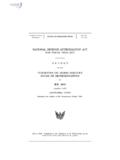Transcription of FDA Regulation of Cosmetics and Personal Care …
1 CRS Report for CongressPrepared for Members and Committees of Congress FDA Regulation of Cosmetics and Personal care Products Amalia K. Corby-Edwards Analyst in Public Health and Epidemiology July 9, 2012 congressional research Service 7-5700 R42594 FDA Regulation of Cosmetics and Personal care Products congressional research Service Summary The 1938 Federal Food, Drug, and cosmetic Act (FFDCA) granted the Food and Drug Administration (FDA) the authority to regulate cosmetic products and their ingredients. The statutory provisions of the FFDCA that address Cosmetics include adulteration and misbranding provisions. In addition to the FFDCA, Cosmetics are regulated under the Fair Packaging and Labeling Act (FPLA) and related regulations . The Cosmetics provisions were amended by the Color Additive Amendments Act of 1960 and the Poison Prevention Packaging Act, but remain basically the same as the provisions in the 1938 FFDCA.
2 FDA s authorities over cosmetic products include some of those applicable to other FDA-regulated products, such as food, drugs, medical devices, and tobacco. For example, FDA has the authority to take certain enforcement actions such as seizures, injunctions, and criminal penalties against adulterated or misbranded Cosmetics . Additionally, as with drug and food companies, FDA may conduct inspections of cosmetic manufacturers and prohibit imports of Cosmetics that violate the FFDCA. The agency also has issued rules restricting the use of ingredients that the agency has determined are poisonous or deleterious. However, FDA s authority over Cosmetics is less comprehensive than its authority over other FDA-regulated products with regard to registration; testing; premarket notification, clearance, or approval; good manufacturing practices; mandatory risk labeling; adverse event reports; and recalls.
3 For example, FDA does not impose registration requirements on cosmetic manufacturers. Rather, cosmetic manufacturers may decide to comply with voluntary FDA regulations on registration. With the exception of color additives, FDA does not require premarket notification, safety testing, review, or approval of the chemicals used in cosmetic products. cosmetic manufacturers also are not required to use good manufacturing practices (GMP) although FDA has released GMP guidelines for cosmetic manufacturers nor required to file ingredient information with, or report adverse reactions to, the agency. Instead, under a voluntary FDA program, cosmetic manufacturers and packagers may report the ingredients used in their product formulations. FDA does not have the authority to require a manufacturer to recall a cosmetic product from the marketplace, although the agency has issued general regulations on voluntary recalls.
4 The agency s ability to issue regulations on cosmetic products is limited by the agency s statutory authorities or lack thereof. As a result, Cosmetics are arguably more self-regulated than other FDA-regulated products. The manner in which a cosmetic product could or should be regulated, however, is not always clear. FDA s guidelines have provided the cosmetic industry with considerable flexibility for product development and claims. The question remains as to whether that flexibility and the extent of government oversight of cosmetic products are still appropriate. FDA Regulation of Cosmetics and Personal care Products congressional research Service Contents 1 Cosmetics , Drugs, and Combination Products .. 2 Cosmetics .. 2 Drugs .. 3 Cosmetics Containing Drug 3 Overview of FDA s Authority to Regulate Cosmetics .
5 5 Adulterated and Misbranded Cosmetics .. 7 Adulteration .. 8 Misbranding and Mislabeling 8 Enforcement .. 9 Voluntary Recalls .. 10 Premarket Approval .. 11 Testing and Safety of cosmetic Ingredients .. 13 cosmetic Ingredient Review Program .. 14 Consumer Concerns About the Safety of Ingredients .. 15 Concerns About Specific Ingredients ..16 Color 17 Coal Tar Hair 18 Nanomaterial Ingredients ..19 Nanotechnology Task Force .. 21 Draft Guidance Regarding the Use of Nanomaterials in FDA-Regulated Products .. 21 Voluntary cosmetic Registration Program .. 22 Reporting of Adverse Reactions to 24 Other Concerns with Labeling .. 25 Organic Labeling Claims on cosmetic Products .. 26 Not Tested on Animals 28 For Professional Use Only Labeling .. 29 Conclusion .. 30 Appendixes Appendix. Keratin Hair Treatments, Also Known as Brazilian Blowouts.
6 31 Contacts Author Contact 39 Acknowledgments .. 40 FDA Regulation of Cosmetics and Personal care Products congressional research Service 1 Introduction The cosmetic , beauty supply, and perfume retail industry consists of approximately 13,000 establishments, with annual revenue of about $10 Worldwide, the Cosmetics and Personal care products industry has more than $250 billion in annual retail According to economic census data released in 2009, the cosmetic industry employs over 86,000 The cosmetic market includes numerous Personal care products that have many uses beyond the facial makeup that one typically thinks of when the term Cosmetics is used. Industry sales are concentrated in the following areas (percentage of sales by product category): (1) Cosmetics , face cream, and perfume 75%; (2) hygienic products including deodorant, shampoo, conditioner, hair color, and shaving products 20%; and (3) small appliances 4%.
7 4 The typical industry consumer is a woman between the ages of 25 to 55, although there appears to be increasing growth in marketing to men and tweens (9- to 12-year-olds).5 Sales of cosmetic and Personal care products may be affected by a consumer s Personal income, although the sales of basic Personal items such as soap, shampoo, and shaving products are likely to be less impacted by a soft economy than other product areas viewed by consumers as more discretionary. 6 Prices for Cosmetics vary widely, and depend on whether the product is a prestige, mass market, or a professional or salon use The Food and Drug Administration (FDA) reportedly regulates $62 billion worth of FDA s primary responsibilities for regulating Cosmetics include ensuring that Cosmetics are not adulterated or This report describes the differences between Cosmetics , drugs, and combination products; provides an overview of the statutory provisions and rules under which FDA regulates Cosmetics ; and provides an overview of industry self- Regulation programs.
8 The report also includes an appendix on keratin hair treatment products, also known as Brazilian Blowouts. This report focuses on FDA Regulation of Cosmetics and does not discuss Federal Trade Commission Regulation of advertising of Cosmetics nor the Regulation of potentially dangerous chemicals or pesticides by other agencies, with the exception of formaldehyde and other agents that may produce or lead to the production of 1 First research , Industry Profile, Cosmetics , Beauty Supply, and Perfume Stores, May 23, 2011. 2 Personal care Products Council, About Us, 3 Census Bureau, 2007 Economic Census, Sector 44: Retail Trade: Industry Series: Preliminary Summary Statistics for the United States, Cosmetics , Beauty Supplies, and Perfume Stores, September 29, 2009.
9 4 First research , supra note 1. 5 First research , Industry Profile, Personal care Products Manufacturing, May 16, 2011. 6 Loran Braverman, CFA, Standard & Poors, NetAdvantage, Sub-Industry Review: Personal Products, ; First research , supra note 5. 7 First research , supra note 5. 8 Department of Health and Human services (HHS), Fiscal Year 2013, Food and Drug Administration, Justification of Estimates for Appropriations Committees, , p. 103. 9 21 361, 362; Federal Food, Drug, and cosmetic Act (FFDCA) 601, 602. 10 Under the Federal Trade Commission Act, [i]t shall be unlawful for any person .. to disseminate, or cause to be disseminated, any false advertisement (1) By United States mails, or in or having an effect upon commerce, by any means, for the purpose of inducing, or which is likely to induce, directly or indirectly the purchase of.
10 Cosmetics ; or ( ) FDA Regulation of Cosmetics and Personal care Products congressional research Service 2 Cosmetics , Drugs, and Combination Products This section discusses the Federal Food, Drug, and cosmetic Act (FFDCA) definitions of Cosmetics and drugs, and how the FFDCA differentiates between Cosmetics and a cosmetic that also meets the statutory definition of a drug. Classification of products is a concern for manufacturers, as Cosmetics are not subject to the same approval, regulatory, or registration requirements as In addition to saving considerable time and expense, this distinction allows manufacturers of products that are only Cosmetics and not drugs or combination products, discussed later, to market their products with less regulatory oversight. Cosmetics The term Cosmetics covers a broad range of FDA-regulated products that may be used externally, orificially, and For regulatory purposes, the term Cosmetics includes products for the eyes, face, nails, hair, skin, and mouth, which may be in the form of products such as makeup, polish, hair dyes and coloring, sunscreens, fragrances, shave gel, oral care and bath products, and products for infants and In some settings, Cosmetics are known as Personal care products because of the wide range of products now regulated as Cosmetics that are not strictly facial Cosmetics .



